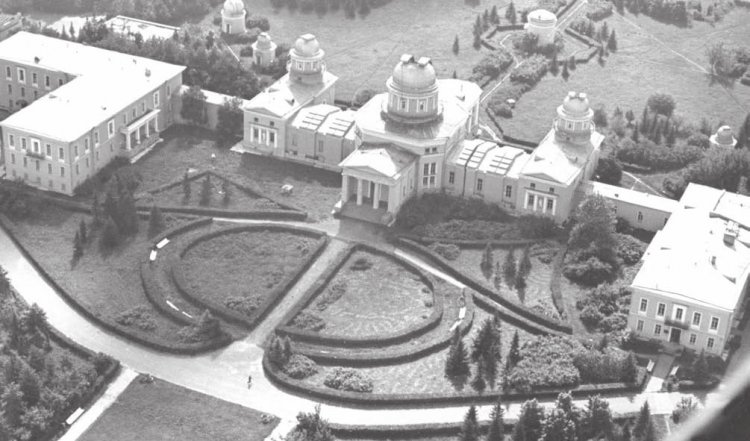On July 3, 1835, ground was broken for the construction of the main building of the Pulkovo Observatory, the main astronomical observatory of the Russian Academy of Sciences. It is a scientific, historical and architectural monument that has become a model of Russian classicism in architecture.
The central building was created according to a design by Aleksandr Pavlovich Bryullov, a famous architect of the 19th century. The original version of the project envisaged an observatory building with three towers and two houses for astronomers’ living quarters. The first building was laid on June 21st (Julian date), 1835, and the observatory itself was opened on August 7th 1839. Research at the observatory is focused on fundamental issues of astronomy: celestial mechanics and stellar dynamics, astrometry (geometric and kinematic parameters of the Universe), the Sun and Sun-Earth coupling, stellar physics and evolution, extragalactic astronomy, equipment and technique of astronomical observations.
Vasily Yakovlevich Struve was appointed the first director of the Pulkovo Observatory. At the outset, in 1839, it had a staff of 7, including the director and 4 astronomers. The headcount had expanded to 13 by 1857: the director, the vice director, 4 senior and 2 associate astronomers, academic secretary, 2 computists.
In addition to astronomical observations, researchers at Pulkovo Observatory performed geographical research (pertaining to navigation) across the entire territory of the Russian Empire. It had computed accurate coordinates for 374 and later 558 stars in the sky. Since 1844, the Pulkovo Meridian passing through the center of the main building of the Pulkovo Observatory has been used as a point of reference for computing geographical longitude. 50 years later, the facility was expanded with an astrophysical laboratory where the world’s largest 76-centimeter Repsold refracting telescope, built by Elvin Clark, was installed. Up to and including 1884, all ships had referenced their longitude to the Pulkovo Meridian. In 1894, using a new device, the astrograph, Pulkovo Observatory staff began their astrophotography studies.
The main building and a view of the research site (1970, photo by V. Samoylov)
During the Great Patriotic War, the observatory was a target of German air raids and artillery bombardment. Even though all the buildings were completely destroyed, most of the equipment was saved, including the lens of the famous 30-inch refractor, as well as a large part of the unique library featuring important works from the 15th to 19th century. Half of the staff had to go to the battlefront while the rest were evacuated to Tashkent to continue their work in the Tashkent Observatory, and Alma Ata, where the Institute of Astronomy and Physics of the Kazakhstan branch of the Academy of Sciences of the USSR was established in 1941. Since 1945 the Pulkovo Observatory had a branch in Crimea (the Simeiz Observatory). The Kislovodsk Mountain Astronomical Station and a laboratory in Blagoveshchensk (the Blagoveshchensk Latitude Station) were established at the same time.
When the war was still raging, a part of observatory buildings had already been restored at their historic location in Leningrad. Later, in 1946, ground was broken for construction work on Pulkovo Hill. The observatory campus was rebuilt under the direction of the architect A.V. Shchusev relying on archived designs by A.P. Bryullov. In 1954, the Pulkovo Observatory opened its doors again. The pre-war functionality was supplemented by a vast number of instruments and additional staffing, enabling the Pulkovo Observatory to expand the range of its scientific pursuits for future research. “In addition, new departments were established such as the radio astronomy department (which later became the St. Petersburg Branch of the RAS Special Astrophysical Observatory) and the instrument fabrication department (with its own optical and mechanical workshop) under the direction of D.D. Maksutov. All preserved instruments were restored, modernized and reinstalled in the observatory,” says the history of the creation of the Pulkovo Observatory.
From 1962 to 1972, the Pulkovo Observatory successfully operated an expedition to Chile (Cerro El Roble Astronomical Station) where it observed objects that are only visible in the Southern Hemisphere. In the 1980s the observatory was active in the Soviet program for tracking the Halley Comet.
Since 1990, the main building of the Pulkovo Observatory has been a part of a UNESCO designated site, Historic Center of St. Petersburg and Related Groups of Monuments.
The Presidential Decree No.275 of April 2nd, 1997, enrolled the Pulkovo Observatory is the State Register of Particularly Valuable Objects of Cultural Heritage of the Peoples of the Russian Federation.
The article is based on open sources.
Photo on the homepage by V. Samoylov Source: History of Petersburg. No 6 (22)/2004






















